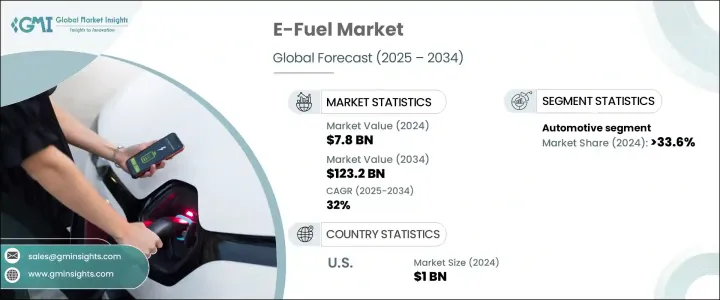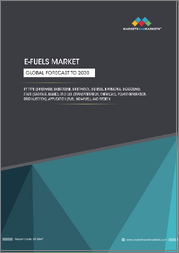
|
시장보고서
상품코드
1716697
전자 연료(E-Fuels) 시장 기회, 성장 촉진요인, 산업 동향 분석, 예측(2025-2034년)E-Fuel Market Opportunity, Growth Drivers, Industry Trend Analysis, and Forecast 2025 - 2034 |
||||||
세계의 전자 연료(E-Fuels) 시장은 2024년에는 78억 달러로 평가되었으며, 2025년부터 2034년에 걸쳐 CAGR 32%로 성장할 것으로 이룰 것으로 예측되고 있습니다.
이 성장은 신재생에너지 기술의 진보, 환경의식의 높아짐, 탄소 배출규제의 엄격화가 주요 요인입니다. 우리는 세계 각국의 정부가 전자 연료(E-Fuels)의 개발을 장려하는 유리한 정책과 인센티브를 도입하여 관련 인프라에 대한 투자를 촉진하고 있습니다.

환경 문제, 특히 항공, 해운, 중수송과 같은 산업으로부터의 온실가스 배출에 대한 우려가 높아져 대체 에너지 솔루션 수요에 박차를 가하고 있습니다. 이러한 부문은 탈탄소화가 어렵기 때문에 전자 연료를 선택하는 것이 매력적입니다. 많은 지역이 재생 가능 연료를 에너지 시스템에 통합하는 틀을 확립하고 있어, 정부의 규제와 인센티브는 전자 연료(E-Fuels)의 채용을 촉진하는데 중요한 역할을 하고 있습니다.
| 시장 범위 | |
|---|---|
| 시작 연도 | 2024년 |
| 예측 연도 | 2025-2034년 |
| 시작 금액 | 78억 달러 |
| 예측 금액 | 1,232억 달러 |
| CAGR | 32% |
전자 연료 제조 공정의 기술 발전과 혁신도 시장 성장에 기여하고 있습니다. 전기분해와 탄소회수의 방법이 개선됨으로써 생산비용이 떨어지고 전자 연료(E-Fuels)의 경제성이 높아지고 있습니다. 풍력발전이나 태양광발전 등의 재생가능에너지를 전자 연료(E-Fuels) 생산에 통합함으로써 이산화탄소 배출량과 운전경비가 절감되어 업계 확대를 더욱 뒷받침하고 있습니다.
전자 연료(E-Fuels) 시장은 제품 유형에 따라 구분되며 e-가솔린, e-디젤, e-케로신, e-메탄올, 에탄올을 포함합니다. 그 중에서도 e-가솔린은 기존 내연기관(ICE) 자동차의 드롭인 연료로서 특히 자동차 분야에서 인기를 끌고 있습니다. 이 성장의 배경에는 현재 인프라에 큰 변화를 가하지 않고 자동차 산업을 탈탄소화하고자 하는 욕구가 있습니다.
용도별로 시장은 주로 자동차, 선박, 항공, 산업 부문으로 나뉘며, 2024년 시장 점유율은 자동차 부문이 33.6% 이상을 차지합니다. 자동차용 전자 연료(E-Fuels) 분야는 특히 인프라와 비용 장벽이 전기자동차(EV)의 보급을 방해하는 지역에서 내연기관으로부터의 배출가스를 삭감하는 중요한 전략으로 성장하고 있습니다. e-휘발유 및 e-디젤과 같은 전자 연료(E-Fuels)는 실용적인 솔루션을 제공하여 기존 급유소와 자동차 엔진이 혼란 없이 운전을 계속할 수 있도록 합니다.
미국에서는 전자 연료(E-Fuels) 시장이 급성장하고 있으며, 그 시장 규모는 2022년 7억 달러에서 2024년에는 10억 달러로 증가했습니다. 또한, 전국의 시설에서 e-fuel을 생산하는 기업간의 제휴도 이 성장에 기여하고 있어, 배송 차량에의 전력 공급과 종래의 연료원에의 의존도의 저감에 중점을 두고 있습니다.
목차
제1장 조사 방법과 조사 범위
제2장 주요 요약
제3장 업계 인사이트
- 생태계 분석
- 규제 상황
- 업계에 미치는 영향요인
- 성장 촉진요인
- 업계의 잠재적 위험 및 과제
- 성장 가능성 분석
- Porter's Five Forces 분석
- PESTEL 분석
제4장 경쟁 구도
- 소개
- 전략 대시보드
- 혁신과 지속가능성의 전망
제5장 시장 규모와 예측 : 재생 가능 에너지원별, 2021년-2034년
- 주요 동향
- 온사이트 및 솔러
- 풍력
제6장 시장 규모와 예측 : 기술별, 2021년-2034년
- 주요 동향
- 피셔 및 트롭쉬
- eRWGS
- 기타
제7장 시장 규모와 예측 : 제품별, 2021년-2034년
- 주요 동향
- E가솔린
- E디젤
- E-케로신
- 에탄올
- 메탄올
- 기타
제8장 시장 규모와 예측 : 용도별, 2021년-2034년
- 주요 동향
- 자동차
- 해양
- 항공
- 산업
- 기타
제9장 시장 규모와 예측 : 지역별, 2021년-2034년
- 주요 동향
- 북미
- 미국
- 캐나다
- 유럽
- 영국
- 독일
- 프랑스
- 네덜란드
- 스페인
- 아시아태평양
- 중국
- 인도
- 일본
- 한국
- 호주
- 중동 및 아프리카
- 사우디아라비아
- 아랍에미리트(UAE)
- 남아프리카
- 라틴아메리카
- 브라질
- 아르헨티나
제10장 기업 프로파일
- Arcadia eFuels
- Archer Daniels Midland
- Ballard Power Systems
- Ceres Power Holding
- Clean Fuels Alliance America
- Climeworks
- Electrochaea
- eFuel Pacific
- ExxonMobil
- FuelCell Energy
- HIF Global
- Infra Synthetic Fuels
- LanzaJet
- Liquid Wind
- MAN Energy Solutions
- Norsk e-Fuel
- Porsche
- Sunfire
The Global E-Fuel Market was valued at USD 7.8 billion in 2024 and is projected to grow at a remarkable CAGR of 32% from 2025 to 2034. This growth can largely be attributed to advancements in renewable energy technologies, increasing environmental awareness, and stricter carbon emission regulations. E-fuels are emerging as a promising solution to overcome the limitations of hydrogen fuel cells and battery electric vehicles (BEVs), offering a viable energy storage option. Governments worldwide are introducing favorable policies and incentives that encourage the development of e-fuels, which is driving investments in related infrastructure.

The rise in environmental concerns, particularly about greenhouse gas emissions from industries like aviation, shipping, and heavy transport, is spurring the demand for alternative energy solutions. These sectors are difficult to decarbonize, making e-fuels a compelling choice. Government regulations and incentives play a crucial role in facilitating e-fuel adoption, with many regions establishing frameworks for integrating renewable fuels into their energy systems.
| Market Scope | |
|---|---|
| Start Year | 2024 |
| Forecast Year | 2025-2034 |
| Start Value | $7.8 Billion |
| Forecast Value | $123.2 Billion |
| CAGR | 32% |
Technological advancements and innovations in the e-fuel production process are also contributing to market growth. Improved methods for electrolysis and carbon capture are helping lower production costs and increase the economic viability of e-fuels. The integration of renewable energy sources, such as wind and solar power, into e-fuel production is reducing the carbon footprint and operational expenses, further supporting industry expansion.
The e-fuel market is segmented based on product type, with categories including e-gasoline, e-diesel, e-kerosene, e-methanol, and ethanol. Among these, e-gasoline is gaining popularity, particularly in the automotive sector, as a drop-in fuel for existing internal combustion engine (ICE) vehicles. This growth is driven by the desire to decarbonize the automobile industry without requiring significant changes to the current infrastructure.
By application, the market is primarily divided into automotive, marine, aviation, and industrial sectors, with the automotive sector accounting for over 33.6% of the market share in 2024. The automotive e-fuel segment is growing as a key strategy to reduce emissions from ICE vehicles, especially in regions where the infrastructure or cost barriers hinder the widespread adoption of electric vehicles (EVs). E-fuels like e-gasoline and e-diesel provide a practical solution, enabling existing fuel stations and vehicle engines to continue operating without disruption.
In the U.S., the e-fuel market has seen rapid growth, with values increasing from USD 0.7 billion in 2022 to USD 1 billion in 2024. This growth is largely fueled by initiatives like the Inflation Reduction Act, which provides incentives for sustainable energy technologies. Additionally, partnerships between companies to produce e-fuel in facilities across the country are contributing to this growth, with a focus on powering delivery fleets and reducing reliance on traditional fuel sources.
Table of Contents
Chapter 1 Methodology & Scope
- 1.1 Market definitions
- 1.2 Base estimates & calculations
- 1.3 Forecast calculation
- 1.4 Data sources
- 1.4.1 Primary
- 1.4.2 Secondary
- 1.4.2.1 Paid
- 1.4.2.2 Public
Chapter 2 Executive Summary
- 2.1 Industry synopsis, 2021 - 2034
Chapter 3 Industry Insights
- 3.1 Industry ecosystem analysis
- 3.2 Regulatory landscape
- 3.3 Industry impact forces
- 3.3.1 Growth drivers
- 3.3.2 Industry pitfalls & challenges
- 3.4 Growth potential analysis
- 3.5 Porter's analysis
- 3.5.1 Bargaining power of suppliers
- 3.5.2 Bargaining power of buyers
- 3.5.3 Threat of new entrants
- 3.5.4 Threat of substitutes
- 3.6 PESTEL analysis
Chapter 4 Competitive landscape, 2024
- 4.1 Introduction
- 4.2 Strategic dashboard
- 4.3 Innovation & sustainability landscape
Chapter 5 Market Size and Forecast, By Renewable Source, 2021 - 2034 (USD Billion)
- 5.1 Key trends
- 5.2 On-site solar
- 5.3 Wind
Chapter 6 Market Size and Forecast, By Technology, 2021 - 2034 (USD Billion)
- 6.1 Key trends
- 6.2 Fischer-tropsch
- 6.3 eRWGS
- 6.4 Others
Chapter 7 Market Size and Forecast, By Product, 2021 - 2034 (USD Billion)
- 7.1 Key trends
- 7.2 E-Gasoline
- 7.3 E-Diesel
- 7.4 E-Kerosene
- 7.5 Ethanol
- 7.6 E-Methanol
- 7.7 Others
Chapter 8 Market Size and Forecast, By Application, 2021 - 2034 (USD Billion)
- 8.1 Key trends
- 8.2 Automotive
- 8.3 Marine
- 8.4 Aviation
- 8.5 Industrial
- 8.6 Others
Chapter 9 Market Size and Forecast, By Region, 2021 - 2034 (USD Billion)
- 9.1 Key trends
- 9.2 North America
- 9.2.1 U.S.
- 9.2.2 Canada
- 9.3 Europe
- 9.3.1 UK
- 9.3.2 Germany
- 9.3.3 France
- 9.3.4 Netherlands
- 9.3.5 Spain
- 9.4 Asia Pacific
- 9.4.1 China
- 9.4.2 India
- 9.4.3 Japan
- 9.4.4 South Korea
- 9.4.5 Australia
- 9.5 Middle East & Africa
- 9.5.1 Saudi Arabia
- 9.5.2 UAE
- 9.5.3 South Africa
- 9.6 Latin America
- 9.6.1 Brazil
- 9.6.2 Argentina
Chapter 10 Company Profiles
- 10.1 Arcadia eFuels
- 10.2 Archer Daniels Midland
- 10.3 Ballard Power Systems
- 10.4 Ceres Power Holding
- 10.5 Clean Fuels Alliance America
- 10.6 Climeworks
- 10.7 Electrochaea
- 10.8 eFuel Pacific
- 10.9 ExxonMobil
- 10.10 FuelCell Energy
- 10.11 HIF Global
- 10.12 Infra Synthetic Fuels
- 10.13 LanzaJet
- 10.14 Liquid Wind
- 10.15 MAN Energy Solutions
- 10.16 Norsk e-Fuel
- 10.17 Porsche
- 10.18 Sunfire




















